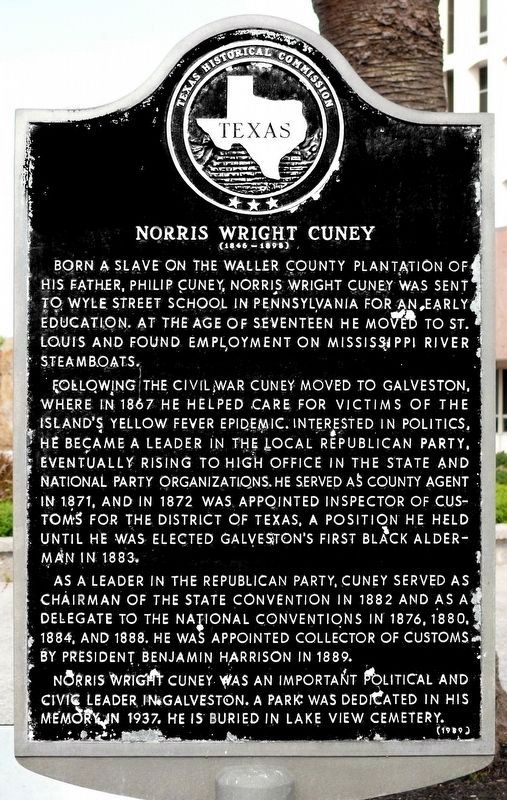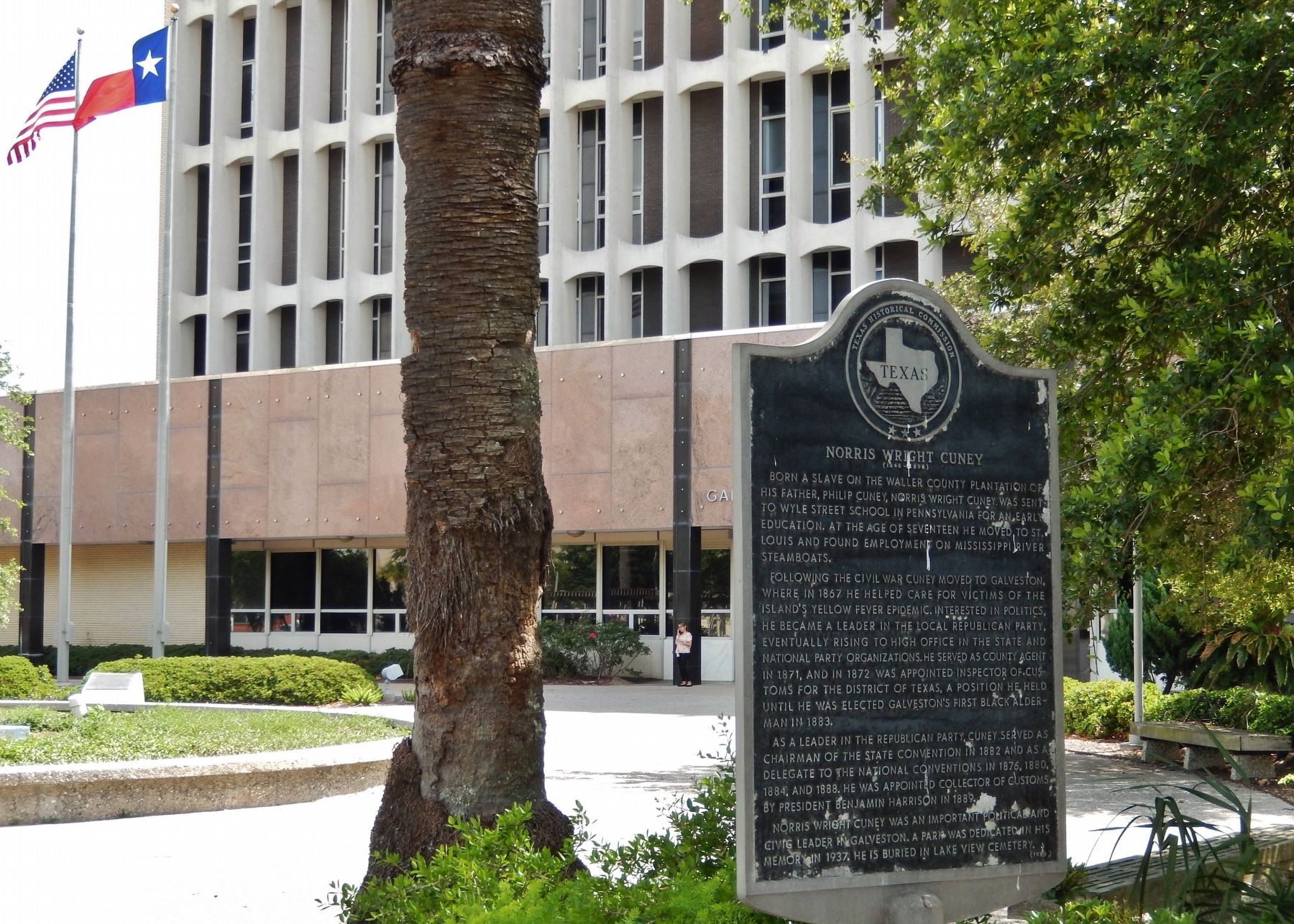Galveston in Galveston County, Texas — The American South (West South Central)
Norris Wright Cuney
(1846-1898)
Born a slave on the Waller County plantation of his father, Philip Cuney, Norris Wright Cuney was sent to Wyle Street School in Pennsylvania for an early education. At the age of seventeen he moved to St. Louis and found employment on Mississippi River steamboats.
Following the Civil War Cuney moved to Galveston, where in 1867 he helped care for victims of the island's yellow fever epidemic. Interested in politics, he became a leader in the local Republican Party, eventually rising to high office in the state and national party organizations. He served as county agent in 1871, and in 1872 was appointed inspector of customs for the District of Texas, a position he held until he was elected Galveston's first black alderman in 1883.
As a leader in the Republican Party, Cuney served as chairman of the state convention in 1882 and as a delegate to the national conventions in 1876, 1880, 1884, and 1888. He was appointed Collector of Customs by President Benjamin Harrison in 1889.
Norris Wright Cuney was an important political and civic leader in Galveston. A park was dedicated in his memory in 1937. He is buried in Lake View Cemetery.
Erected 1989 by Texas Historical Commission. (Marker Number 12625.)
Topics and series. This historical marker is listed in these topic lists: African Americans • Government & Politics. In addition, it is included in the Former U.S. Presidents: #23 Benjamin Harrison series list.
Location. 29° 18.178′ N, 94° 47.395′ W. Marker is in Galveston, Texas, in Galveston County. Marker can be reached from Avenue H east of Moody Avenue, on the right when traveling west. Marker is located on the Galveston County Courthouse grounds, in front of the courthouse, amongst the trees within the inner ring of the courthouse plaza, south of the plaza center. Touch for map. Marker is at or near this postal address: 722 Moody Avenue, Galveston TX 77550, United States of America. Touch for directions.
Other nearby markers. At least 8 other markers are within walking distance of this marker. Galveston County Communities (here, next to this marker); [Galveston County] 1901-1965 (a few steps from this marker); Rabbi Henry Cohen (a few steps from this marker); Dignified Resignation (a few steps from this marker); The Rt. Rev. Monsignor James Martin Kirwin (a few steps from this marker); Reconstruction to 1900 (within shouting distance of this marker); Texas Revolution and Civil War
(within shouting distance of this marker); Exploration (within shouting distance of this marker). Touch for a list and map of all markers in Galveston.
More about this marker. Marker is significantly weathered and difficult to read.
Also see . . .
1. Norris Wright Cuney.
In 1873 Cuney was appointed secretary of the Republican State Executive Committee. He was defeated in the race for mayor of Galveston in 1875 and for the state House and Senate in 1876 and 1882 respectively. But in appointed offices and as a dispenser of patronage, Cuney was powerful. He became inspector of customs of the port of Galveston and revenue inspector at Sabine Pass in 1872, special inspector of customs at Galveston in 1882, and finally collector of customs of the port of Galveston in 1889. In 1886 he became Texas national committeeman of the Republican party, the most important political position given to a black man of the South in the nineteenth century. (Submitted on June 5, 2018, by Cosmos Mariner of Cape Canaveral, Florida.)
2. Norris Wright Cuney.
Cuney was the child of a white planter, Philip Minor Cuney. His mother, Adeline Stuart, was Cuney's slave. Evidently recognized as Cuney's child, he was educated in Pennsylvania at the Wylie Street School for blacks in Pittsburgh, Pennsylvania. The Civil War and the end of slavery also ended Cuney's preparatory education. Cuney studied law, but politics became his ladder to success through his support of Radical Republican Governor Edmund J. Davis. Cuney remained powerful within the Republican Party because he could influence African American voters and because he remained the party's primary advisor in patronage to that constituency. (Submitted on June 5, 2018, by Cosmos Mariner of Cape Canaveral, Florida.)
3. Norris Wright Cuney.
Some Texas historians refer to the period of the state between 1884 and 1896 as the "Cuney era". It is noted as a time of significant political gains by blacks in Texas. Cuney's efforts to recruit and register blacks contributed to a total of more than 100,000 blacks voting annually in the state during the 1890s. By the time of Cuney's death, white conservative Democratic-dominated southern state legislatures were passing new constitutions and laws to disenfranchise blacks and poor white voters to expel them from politics. From 1890 to 1908, beginning with Mississippi, state legislatures created barriers to voter registration that resulted in dramatic reductions of voter rolls and nearly total exclusion of blacks from the political systems. (Submitted on June 5, 2018, by Cosmos Mariner of Cape Canaveral, Florida.)
Credits. This page was last revised on December 27, 2019. It was originally submitted on June 5, 2018, by Cosmos Mariner of Cape Canaveral, Florida. This page has been viewed 368 times since then and 36 times this year. Last updated on December 25, 2019, by Jim Evans of Houston, Texas. Photos: 1. submitted on December 19, 2019, by Jim Evans of Houston, Texas. 2. submitted on June 5, 2018, by Cosmos Mariner of Cape Canaveral, Florida. • J. Makali Bruton was the editor who published this page.

